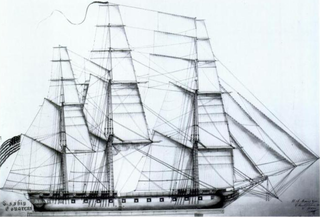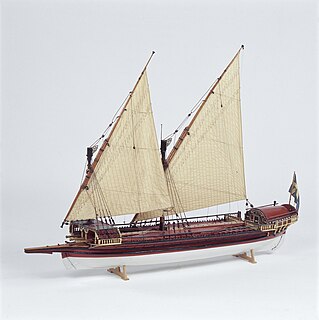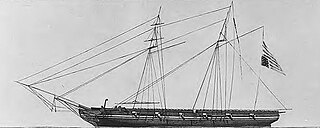The first USS Sea Horse was a one-gun schooner that the Navy purchased in 1812 for service on Lake Borgne, near New Orleans, Louisiana. She was one of 15 vessels available to Commodore Daniel Todd Patterson in New Orleans at the outbreak of war with Britain in 1812. She saw action as part of a squadron of gunboats, under the command of Lieutenant Thomas ap Catesby Jones, that in December 1814 opposed the British advance on New Orleans.

HMS Tonnant was an 80-gun ship of the line of the Royal Navy. She had previously been Tonnant of the French Navy and the lead ship of the Tonnant class. The British captured her in August 1793 during the Siege of Toulon but the French recaptured her when the siege was broken in December. Rear-Admiral Horatio Nelson captured her at Aboukir Bay off the coast of Egypt at the Battle of the Nile on 1 August 1798. She was taken into British service as HMS Tonnant. She went on to fight at the Battle of Trafalgar in 1805, during the Napoleonic Wars.
USS Julia was a schooner in the United States Navy during the War of 1812. Initially the privately-owned schooner Julia, she was captured at the onset of the war by armed boats looking for violators of President James Madison's embargo of trade with the British. Purchased by the United States Navy, the vessel was armed with two guns and made part of the squadron on Lake Ontario. Julia took part in the Battle of York and the Battle of Fort George. In August 1813, the schooner was captured by the Royal Navy after failing to execute a turn and was put in service as HMS Confiance. The vessel continued as a warship in British service for a couple of weeks before being converted to a troop transport. In October, Confiance was recaptured by the Americans and renamed Julia. No longer considered capable as a warship, the vessel was retired from service.

USS Alligator was a sloop in the United States Navy during the War of 1812. The U.S. Navy purchased Alligator in 1813 at New Orleans, Louisiana. Commissioned as a tender at New Orleans, she served on that station under the command of Sailing Master Richard S. Sheppard until late in 1814 when the British captured her at the Battle of Lake Borgne.

HMS Royal Oak was a 74-gun third rate ship of the line of the Royal Navy, launched on 4 March 1809 at Dudman's yard at Deptford Wharf. Her first commanding officer was Captain Pulteney Malcolm.

HMS Fantome was an 18-gun brig-sloop of the Royal Navy. She was originally a French privateer brig named Fantôme, which the British captured in 1810 and commissioned into British service. Fantome saw extensive action in the War of 1812 until she was lost in a shipwreck at Prospect, Nova Scotia, near Halifax in 1814.

HMS Alceste was built at Rochefort in 1804 for the French Navy as Minerve, an Armide-class frigate. In the spring of 1806, prior to her capture, she engaged HMS Pallas, then under Lord Cochrane. During the duel she ran aground but Cochrane had to abort his attack when French reinforcements appeared.
HMS Anaconda was an 18-gun brig-sloop of the Royal Navy during the War of 1812. She was cruising as an American privateer until sailors from HMS Sceptre captured her in 1813. She served briefly in the Royal Navy during the later stages of the War of 1812, especially at the Battle of New Orleans, before being sold in Jamaica in 1815.

HMS Sophie was an 18-gun Cruizer class brig-sloop of the Royal Navy. She served during the Napoleonic Wars and the War of 1812. During the War of 1812 Sophie participated in the economic war against American trade, capturing or destroying numerous small merchant vessels, and in an unsuccessful attack on Fort Bowyer, Alabama. Later, she moved to the East Indies where she served in the First Anglo-Burmese War. The Admiralty sold Sophie in 1825.

HMS Lark was a 16-gun ship sloop of the Cormorant class, launched in 1794 at Northfleet. She served primarily in the Caribbean, where she took a number of prizes, some after quite intensive action. Lark foundered off San Domingo in August 1809, with the loss of her captain and almost all her crew.

Armide was a 40-gun frigate of the French Navy, lead ship of her class, and launched in 1804 at Rochefort. She served briefly in the French Navy before the Royal Navy captured her in 1806. She went on to serve in the Royal Navy until 1815 when she was broken up.

The Battle of Lake Borgne was a battle between the Royal Navy and the U.S. Navy in the American South theatre of the War of 1812. It occurred on December 14, 1814 on Lake Borgne. The British victory allowed them to disembark their troops unhindered nine days later and to launch an offensive upon New Orleans on land.

The Siege of Fort St. Philip was a battle taking place during the ending of the War of 1812 between a sizable British naval fleet attempting to sail the Mississippi River by force in order to provide reinforcements to British forces already attacking New Orleans as part of the Louisiana Campaign, and the single American garrison of Fort St. Philip guarded by a far numerically-inferior force. The siege lasted from January 9 to January 18, 1815.

The West Indies Squadron, or the West Indies Station, was a United States Navy squadron that operated in the West Indies in the early nineteenth century. It was formed due to the need to suppress piracy in the Caribbean Sea, the Antilles and the Gulf of Mexico region of the Atlantic Ocean. This unit later engaged in the Second Seminole War until being combined with the Home Squadron in 1842. From 1822 to 1826 the squadron was based out of Saint Thomas Island until the Pensacola Naval Yard was constructed.

The New Orleans Squadron or the New Orleans Station was a United States Navy squadron raised out of the growing threat the United Kingdom posed to Louisiana during the War of 1812. The first squadron consisted of over a dozen vessels and was mostly defeated during the war. Afterward, new ships were stationed at New Orleans which engaged in counter-piracy operations for over twenty years. The New Orleans Squadron was eventually merged with the Home Squadron.

The archipelago fleet, officially the Fleet of the army, was a branch of the armed forces of Sweden which existed between 1756 and 1823. Its purpose was to protect the coasts of Sweden, which was surrounded by a natural barrier of archipelagoes. Throughout its existence, it was a largely independent arm of the army, separate from the navy, with the exception of a few years in the late 1760s. In a number of respects, it was a precursor of the Swedish Coastal Artillery and its coastal fleet.

The West Indies Anti-Piracy Operations refer to the United States Navy presence in the Antilles, and surrounding waters, which fought against pirates. Between 1817 and 1825, the American West Indies Squadron constantly pursued pirates on sea and land, primarily around Cuba and Puerto Rico. After the capture of Roberto Cofresi in 1825, acts of piracy became rare, and the operation was considered a success, although limited occurrences went on until slightly after the start of the 20th century.

United States Navy operations during World War I began on April 6, 1917, after the formal declaration of war on the German Empire. The American navy focused on countering enemy U-boats in the Atlantic Ocean and the Mediterranean Sea, while convoying men and supplies to France and Italy. Because of United States' late entry into the war, her capital ships never engaged the German fleet, and few decisive submarine actions occurred.
Sir George Augustus Alexander Westphal was a Nova Scotian admiral in the Royal Navy who served in more than 100 actions. He was midshipman on HMS Victory during the Battle of Trafalgar.
The hired armed brig Colpoys was a French vessel launched in 1803 that a Briton acquired that year. He chartered her to the Royal Navy from 28 April 1804 until 22 August 1807. She was originally a schooner that apparently was converted to a brig in early 1805. She participated in the blockade of Brest and captured numerous small vessels. After Colpoys's contract ended she is listed until 1811, but there are no other traces of her.














